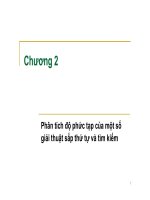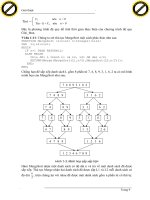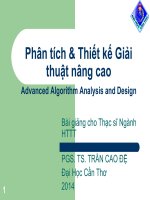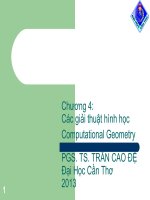Slide phân tích và thiết kế giải thuật algorithm analysis and design
Bạn đang xem bản rút gọn của tài liệu. Xem và tải ngay bản đầy đủ của tài liệu tại đây (264.13 KB, 46 trang )
.c
om
ng
th
an
co
Algorithm Analysis and Design
du
o
ng
Dr. Truong Tuan Anh
cu
u
Faculty of Computer Science and Engineering
Ho Chi Minh City University of Technology
VNU- Ho Chi Minh City
1
CuuDuongThanCong.com
/>
.c
om
References
ng
[1] Cormen, T. H., Leiserson, C. E, and Rivest, R. L.,
Introduction to Algorithms, The MIT Press, 2009.
an
co
[2] Levitin, A., Introduction to the Design and Analysis
of Algorithms, 3rd Edition, Pearson, 2012.
du
o
ng
th
[3] Sedgewick, R., Algorithms in C++, AddisonWesley, 1998.
cu
u
[4] Weiss, M.A., Data Structures and Algorithm
Analysis in C, TheBenjamin/Cummings Publishing,
1993.
2
CuuDuongThanCong.com
/>
Course Outline
.c
om
1. Basic concepts on algorithm analysis and design
ng
2. Divide-and-conquer
th
an
4. Transform-and-conquer
co
3. Decrease-and-conquer
ng
5. Dynamic programming and greedy algorithm
du
o
6. Backtracking algorithms
cu
u
7. NP-completeness
8. Approximation algorithms
3
CuuDuongThanCong.com
/>
1. Able to analyze the complexity of the
algorithms (recursive or iterative) and estimate
the efficiency of the algorithms.
2. Improve the ability to design algorithms in
different areas.
3. Able to discuss on NP-completeness
an
du
o
u
cu
ng
th
co
ng
.c
om
Course outcomes
4
CuuDuongThanCong.com
/>
ng
co
an
th
Sakai
Website: www4.hcmut.edu.vn/~anhtt/
ng
du
o
u
Class
Email:
Slides:
cu
.c
om
Contacts
5
CuuDuongThanCong.com
/>
u
du
o
ng
th
an
co
ng
Recursion and recurrence relations
Analysis of algorithms
Analysis of iterative algorithms
Analysis of recursive algorithms
Algorithm design strategies
Brute-force algorithm design
cu
1.
2.
3.
4.
5.
6.
.c
om
Outline
6
CuuDuongThanCong.com
/>
1. Recursion
.c
om
Recurrence relation
ng
th
an
co
ng
Example 1: Factorial function
N! = N.(N-1)!
if N ≥ 1
0! = 1
The definition for a recursive function which contains some
integer parameters is called a recurrence relation.
cu
u
du
o
function factorial (N: integer): integer;
begin
if N = 0
then factorial: = 1
else factorial: = N*factorial (N-1);
end;
7
CuuDuongThanCong.com
/>
Recurrence relation
ng
co
th
an
Recurrence relation:
FN = FN-1 + FN-2
for N ≥ 2
F0 = F1 = 1
1, 1, 2, 3, 5, 8, 13, 21, …
.c
om
Example 2: Fibonacci number
cu
u
du
o
ng
function fibonacci (N: integer): integer;
begin
if N <= 1
then fibonacci: = 1
else fibonacci: = fibonacci(N-1) +
fibonacci(N-2);
end;
8
CuuDuongThanCong.com
/>
computed
cu
u
du
o
ng
th
an
co
ng
.c
om
Fibonacci numbers – Recursive tree
CuuDuongThanCong.com
There exist several
redundant computations
when using recursive
function to compute
Fibonacci numbers.
/>
9
.c
om
By contrast, it is very easy to compute Fibonacci numbers by
using an array in a non-recursive algorithm.
cu
u
du
o
ng
th
ng
co
an
procedure fibonacci;
const max = 25;
var i: integer;
F: array [0..max] of integer;
begin
F[0]: = 1; F[1]: = 1;
for i: = 2 to max do
F[i]: = F[i-1] + F[i-2]
end;
A non-recursive (iterative)
algorithm often works more
efficiently than a recursive
algorithm. It is easier to debug
an iterative algorithm than a
recursive algorithm.
By using stack, we can
convert a recursive algorithm
to an equivalent iterative
algorithm.
10
CuuDuongThanCong.com
/>
2. Analysis of algorithms
co
ng
.c
om
For most problems, many different algorithms are available.
How one to choose the best algorithm?
How to compare the algorithms which can solve the same
problem?
du
o
Resources:
ng
th
an
Analysis of an algorithm: estimate the resources used by that
algorithm.
cu
u
Memory space
Computational time
Computational time is the most important resource.
11
CuuDuongThanCong.com
/>
Two ways of analysis
ng
.c
om
The computational time of an algorithm is a
function of N, the amount of data to be processed.
an
th
The average case: the amount of time an
algorithm might be expected to take on “typical”
input data.
du
o
ng
•
co
We are interested in:
cu
u
• The worst case: the amount of time an algorithm
would take on the worst possible input data.
12
CuuDuongThanCong.com
/>
Framework of complexity analysis
an
co
ng
.c
om
♦ Step 1: Characterize the data which is to be used as input to
the algorithm and to decide what type of analysis is
appropriate.
Normally, we concentrate on
- proving that the running time is always less than some
“upper bound”, or
- trying to derive the average running time for a random input.
cu
u
du
o
ng
th
♦ Step 2: identify abstract operation upon which the algorithm
is based.
Example: comparison is the abstract operation in sorting
algorithm.
The number of abstract operations depends on a few quantities.
♦ Step 3: Proceed to the mathematical analysis to find averageand worst-case values for each of the fundamental quantities.
13
CuuDuongThanCong.com
/>
The two cases of analysis
.c
om
• It is not difficult to find an upper bound on the running
time of an algorithm.
co
ng
• But the average case normally requires a sophisticated
mathematical analysis.
u
du
o
ng
th
an
• In principle, the performance of an algorithm often can
be analyzed to an extremely precise level of detail. But
we are always interested in estimating in order to
suppress detail.
cu
• In short, we look for rough estimates for the running
time of our algorithm for purposes of classification of
complexity.
14
CuuDuongThanCong.com
/>
Classification of Algorithm complexity
.c
om
Most algorithms have a primary parameter, N, the number of
data items to be processed.
th
an
co
ng
Examples:
Size of the array to be sorted or searched.
The number of nodes in a graph.
du
o
ng
All of the algorithms have running time proportional to the
following functions
cu
u
1. If the basic operation in the algorithm is executed once or a
few times.
⇒ its running time is constant.
2. lgN (logarithmic)
The algorithm gets slightly slower as N grows.
CuuDuongThanCong.com
log2N ≡ lgN
15
/>
.c
om
3. N (linear)
4. NlgN
in a double nested loop
6. N3 (cubic)
in a triple nested loop
th
an
co
ng
5. N2 (quadratic)
ng
Few algorithms with exponential running time.
u
du
o
7. 2N
cu
Some of algorithms may have running time proportional to
N3/2, N1/2 , (lgN)2 …
16
CuuDuongThanCong.com
/>
.c
om
ng
co
an
th
ng
du
o
u
cu
17
CuuDuongThanCong.com
/>
Computational Complexity
co
ng
.c
om
Now, we focus on studying the worst-case performance. We
ignore constant factors in order to determine the functional
dependence of the running time on the number of inputs.
th
an
Example: One can say that the running time of mergesort is
proportional to NlgN.
cu
u
du
o
ng
The first step is to make the notion of “proportional to”
mathematically precise.
The mathematical artifact for making this notion precise
is called the O-notation.
18
CuuDuongThanCong.com
/>
cu
u
du
o
ng
th
an
co
ng
.c
om
Definition: A function f(n) is said to be O(g(n)) if there exists
constants c and n0 such that f(n) is less than cg(n) for all n > n0.
19
CuuDuongThanCong.com
/>
.c
om
O Notation
co
ng
The O notation is a useful way to state upper bounds on
running time which are independent of both inputs and
implementation details.
ng
th
an
We try to provide both an “upper bound” and “lower
bound” on the worst-case running time.
cu
u
du
o
Providing lower-bound is a difficult matter.
20
CuuDuongThanCong.com
/>
Average-case analysis
ng
th
an
co
ng
.c
om
For this kind of analysis, we have to
- characterize the inputs to the algorithm
- calculate the average number of times each
instruction is executed,
- calculate the average running time of the algorithm.
cu
u
du
o
But
- Average-case analysis requires detailed
mathematical arguments.
- It’s difficult to characterize the input data
encountered in practice.
21
CuuDuongThanCong.com
/>
Approximate and Asymptotic results
co
ng
.c
om
Often, the results of a mathematical analysis are not exact but
are approximate: the result might be an expression consisting
of a sequence of decreasing terms.
th
an
We are most concerned with the leading term of a
mathematical expression.
cu
u
du
o
ng
Example: The average running time of the algorithm is:
a0NlgN + a1N + a2
But we can rewrite as:
a0NlgN + O(N)
For large N, we may not need to find the values of a1 or a2.
22
CuuDuongThanCong.com
/>
.c
om
Approximate and Asymptotic results (cont.)
co
ng
The O notation provides us with a way to get an
approximate answer for large N.
cu
u
du
o
ng
th
an
Therefore, we can ignore some quantities represented
by the O-notation when there is a well-specified leading
(larger) term in the expression.
Example: If the expression is N(N-1)/2, we can refer to it
as “about” N2/2.
23
CuuDuongThanCong.com
/>
3. Analysis of an iterative algorithm
element in an array.
cu
u
du
o
ng
th
an
co
ng
procedure MAX(A, n, max)
/* Set max to the maximum of A(1:n) */
begin
integer i, n;
max := A[1];
for i:= 2 to n do
if A[i] > max then max := A[i]
end
.c
om
Example 1 Given the algorithm that finds the largest
Let denote C(n) the complexity of the algorithm when
comparison (A[i]> max) is considered as basic operation.
Let determine C(n) in the worst-case analysis.
24
CuuDuongThanCong.com
/>
Analysis of an iterative algorithm (cont.)
.c
om
If the basic operation of the MAX procedure is comparison.
co
ng
The number of times the comparison is executed is also the
number of the body of the loop is executed:
(n-1).
an
So, the computational complexity of the algorithm is O(n).
du
o
ng
th
This also the complexity of the two cases: worst-case and
average-case.
Note: If the basic operation is assignment (max := A[i])?
cu
u
then O(n) is the complexity of the worst-case.
25
CuuDuongThanCong.com
/>









